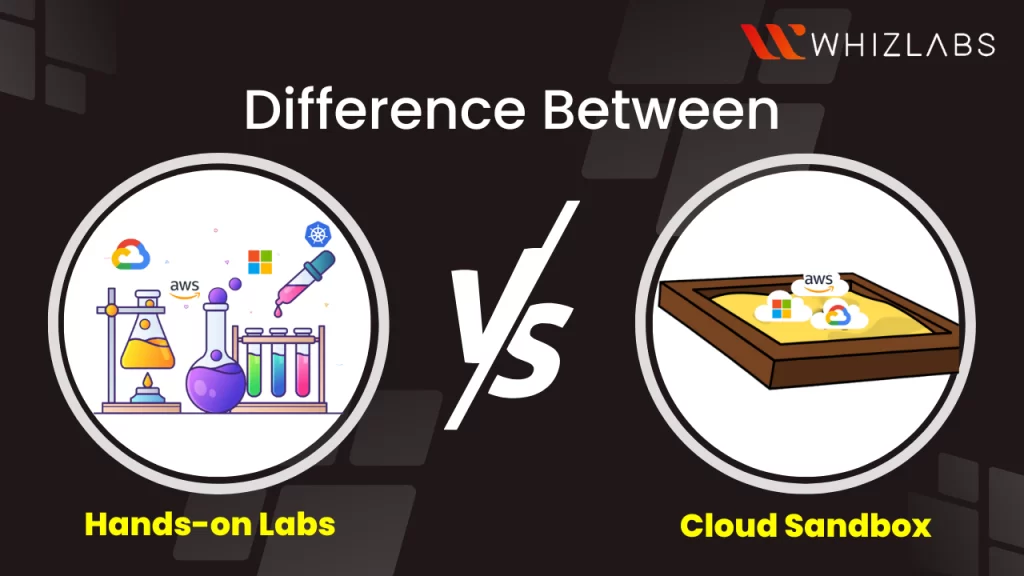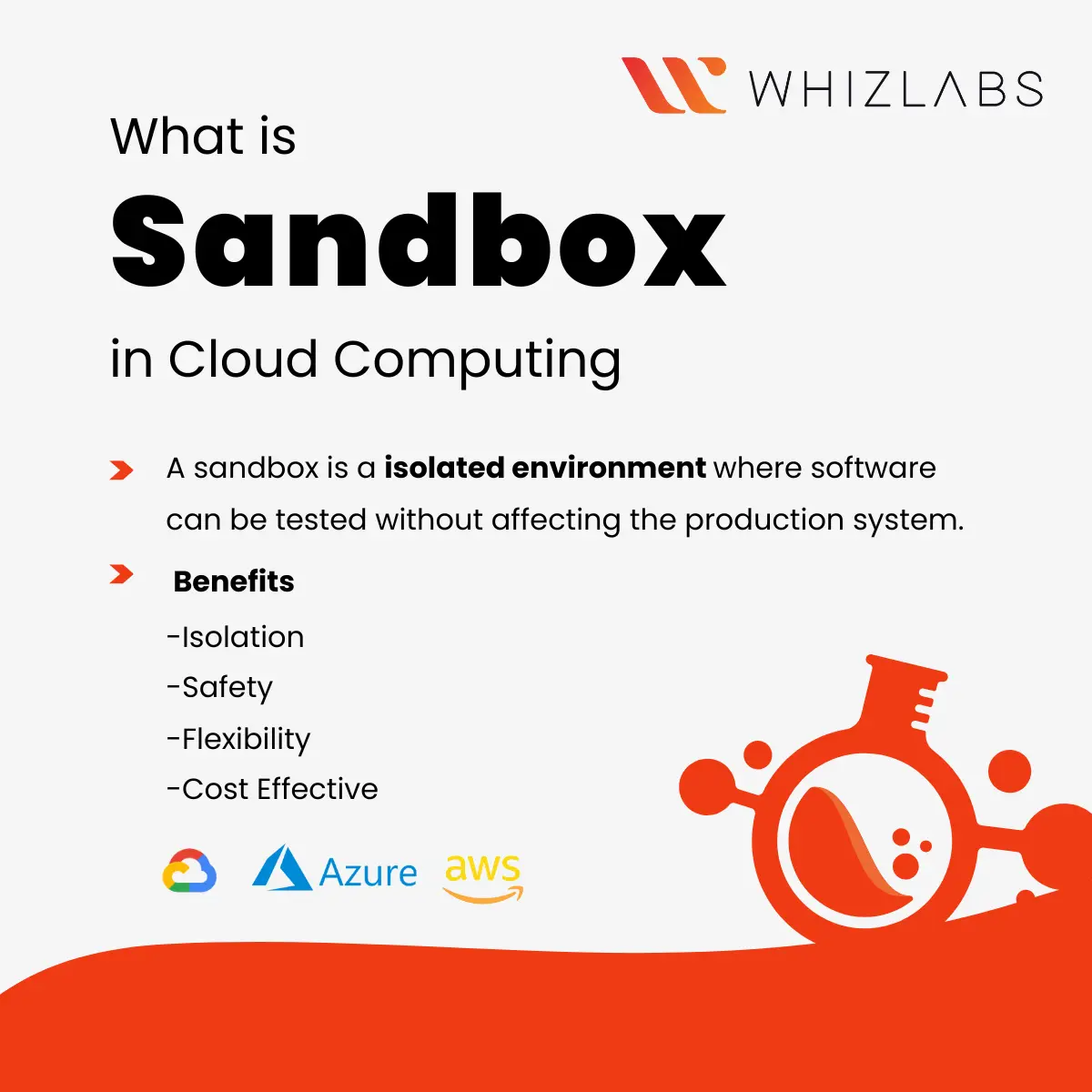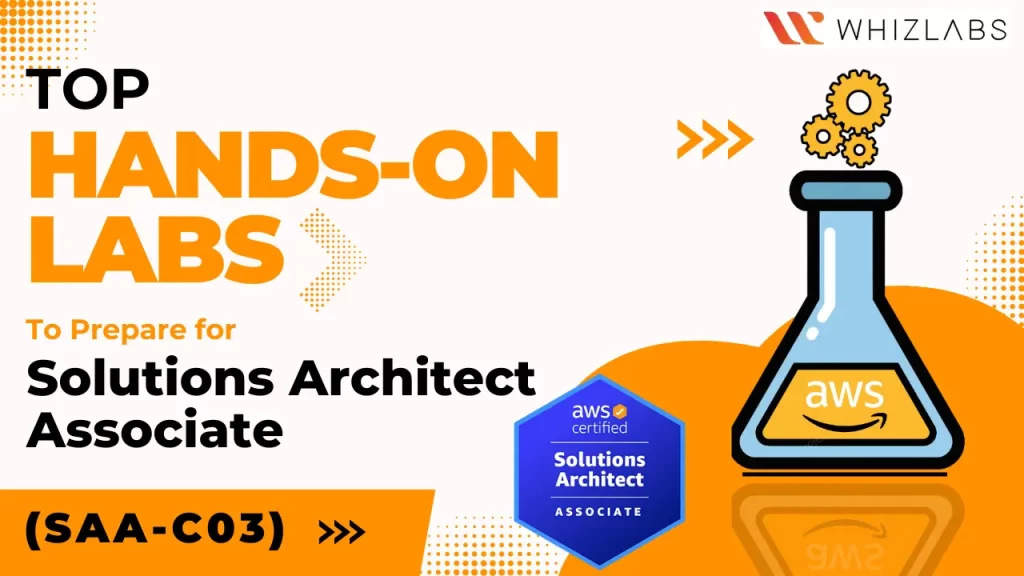What is the best way to ensure a complete in-depth preparation of any cloud computing course? It’s by putting all your theoretical knowledge into practice and testing your skills in a real-world scenario. Speaking of which, hands-on labs and sandboxes are two critical tools to prepare for any certification that helps you sharpen your hands-on experience and experiment with your abilities in a demo cloud environment.
While the two names are hard to differentiate, there’s still a fine line of technical difference that makes them suitable for different purposes.
This blog talks in detail about the nuances of hands-on labs and sandboxes and examines the factors that make them different from each other.
Let’s dive in!
What is a Sandbox in Cloud computing?
Sandbox refers to an isolated and demo cloud environment wherein users can execute applications or browse files and run them on any platform or system without worrying about any impact on the backend.
Moreover, sandboxes are mostly used by software developers and architects to test new computer code. Similarly, cyber security professionals leverage sandboxes to evaluate potentially harmful programs.
Sandboxing is basically a wall between experiments and the network. It holds down your fort while you play around. Or else, the chances are unethical users can sneak in without hassles and gain unlimited access to critical info and system resources on infrastructure.
Additionally, sandboxing helps uncover malicious codes safely without endangering your system, the network, or other connected devices. It provides an additional layer of defense against security risks, such as exploits and stealth attacks employing zero-day vulnerabilities.
Read More: Sandbox in cloud computing
Types of Sandbox environments
Sandboxes can be used for different purposes and platforms. While we are talking about cloud computing, here are some of the prominent sandboxes.
AWS Sandboxes
AWS sandboxes include services like:
- AWS compute services like Amazon EC2, AWS Lambda, Elastic Load Balancing, etc.
- AWS storage Amazon S3 and Amazon Glacier.
- Amazon Database like Amazon DynamoDB
- Developer tools like AWS code pipeline, AWS cloud shell, etc.
- Amazon Athena for analytics
- AWS network and content delivery features like Amazon Virtual Private Cloud
- AWS compliance services like IAM and AWS secret manager
Azure Sandboxes
Azure Sandboxes help you control VMs and allocate resources without any hassles. The package includes:
- Computing resources like Kubernetes, Container registries, Disks, etc.
- The network features like Load Balancer and NAT Gateway.
- Database management with Cosmos, Azure SQL, Azure Database for PostgreSQL Server, etc.
- Storage features like Blob, Table, and File Share
- Azure app service plan
- Application insights and alerts
Google Cloud Sandbox
The Google Cloud Sandbox lets you verify your expertise in a secure setting. It includes:
- Compute resources like Google Kubernetes and VM instance
- Serverless features
- Database functions like Cloud SQL, Cloud spanner, and Big Table
- Analytics like BigQuery and Dataflow
Also Read : A journey into our Whizlabs Sandbox Environments
Features of Sandboxes
Sandboxes are easy to use and make your experiment and testing process a breeze. Here are a few exclusive features of sandboxes:
- You get hands-on learning. You can practice and learn while developing a holistic view of cloud environments and solution architecture. In the end, you will find a lot of confidence as you sharpen your skills with the nuances.
- You save installation struggles. Sandboxes don’t require any server installation or maintenance.
- It’s a siloed environment. Generally, this would mean a negative trait, but here it’s a boon since no errors, bugs, or features would affect your network or system.
- It consists of automated removal. All drafts will be immediately removed once you have finished implementing and testing your ideas in the interface.
- It offers easy data uploading. It is simple to upload data and apps, test them for results, make modifications, and execute them as many times till you get accurate results. Additionally, you can transfer data between several cloud providers.
Why are sandboxes vital for you?
There are a million reasons why you need to care about sandboxes. But for starters, sandboxes will help gain an in-depth understanding of technologies and dive deeper into operating in a cloud environment. Apart from this, sandboxes will help you:
- Improve your knowledge of the solution’s weaknesses and remove them from the permanent apps. The faults will only impact the virtual environments because you execute them on web browsers and not in the actual infrastructure.
- Know your tools and help you distinguish between trustworthy and dangerous software, saving your systems from endangering the equipment.
- Learn how technologies like AWS secret manager can improve the security of your infrastructure by conducting in-depth security research.
- Know technical fundamentals like BigQuery in detail and be able to identify and safely delete questionable apps.
When do you need a Sandbox?
You can use sandboxes to execute a code in a silo in any scenario, just like you do for an actual software execution in normal circumstances. You can use a sandbox to:
- Run and experiment on a web browser. If a browser reacts to a vulnerability, it will be limited only to the demo environment and won’t travel on your network.
- Find security measures for software. There are numerous tools that will help you pilot-test software in a sandbox and prevent any access to your critical info. Sandbox is a complete system in itself. Therefore, it will let you play around, code, and strengthen weak spots to eliminate future vulnerabilities.
- Conduct security research. You can run apps in sandboxes, detect faults and vulnerabilities beforehand and remove them. For instance, you can deploy security tools into a browser and app and analyze if it’s capable enough to remove threats.
What are hands-on labs?
Similar to sandboxes, hands-on labs also represent a demo environment wherein you can dive deeper into the fundamentals of a cloud environment, its features, and solutions. Upskilling in the cloud is a lot more than theoretical knowledge.
So many certification courses list down countless prior-required skills, and there are two ways to prepare. Either, you look for an internship with good mentors. Or, you turn to hands-on labs to sharpen your practical skills.
Interestingly, almost all training programs and certificatiom exam portals offer paid and free hands-on labs. These labs are not only nuanced but also curated by industry experts and tailor-made for cloud certifications.
For instance, if you want to appear for the Certified Kubernetes Administration (CKA) exam, you can use hands-on labs on Kubernetes containers, Kubectl, Tmux, etc.
Beginner’s Guide: All about Hands-On Labs?
Types of hands-on labs
Numerous characteristics define the style and nature of hands-on labs. In other words, you will find guided labs, challenge labs for daily challenges, labs based on roles, certifications, types of platforms, and so on. Let’s have a quick look at them.
Labs based on platforms
Labs can be based on various cloud platforms and cloud services. These mainly include labs for AWS, Azure, Google, Power Platforms, etc. You can access AWS self-paced labs to enhance your practical skills. Some of the prominent ones are:
- Amazon Elastic Compute Cloud (EC2)
- Amazon Cloudfront
- Blob storage
- Use CLI to add data disks to VM
- Google Cloud SQL
- Taints and tolerations in GKE
Labs based on level of expertise
- Beginners
- Intermediate
- Advanced
Labs based on certification
You hands-on labs for certifications like:
- AZ-500
- AWS-certified cloud practitioner
- AWS-certified data analytics
- DP-203
- Google-certified associate cloud engineer
- Google-certified professional cloud developer
Labs based on roles
You will find hands-on labs to prepare for roles like:
- Cloud Architect
- Cloud consultant
- Data Engineer
- Data scientist
- Machine learning developer
- Machine learning engineer
Labs based on the purpose
Guided labs
These labs help you understand concepts and exam topics in detail. You receive supervision while performing the task. Each task will have cloud services and a specific set of instructions to follow.
Lab Challenges
As the word suggests, these are labs dedicated to challenges/puzzles based on cloud concepts and fundamentals. You need to solve and perform those tasks without any assistance. If you are unable to come up with a solution, the system may leave you some clues to lead to the end. This is the best way to improve your perspectives on real-world problems.
Project-based labs
These labs are based on specific assignments. They allow you to use cloud services to build projects and aid you in grasping complex structures found in cloud environments. You can also develop projects, including both intra-cloud and inter-cloud services.
Features of hands-on labs
Hands-on labs are designed to match the skill gap for various roles and certifications. They make operating in a cloud environment a breeze. In addition:
- Hands-on labs are user-friendly. They offer:
– Easy installation of cloud environments
– Hassle-free running of apps
– No extra charges for server installations
– Easy ways to put theory into practice
- Hands-on labs offer a seamless user experience. They provide:
– Super easy login
– Detailed instruction
– User-friendly cloud console
– Sequential navigation
– Better accessibility
Why are hands-on labs vital for you?
Hands-on labs is the best way to understand real-world scenarios. Theories only explain the scope and purpose of a concept. But you will find a million things different and unique when you apply that theory in a practical situation. That’s what hands-on labs are for. It bridges the gap between a concept’s theoretical and practical aspects and helps you understand how to leverage it.
Apart from this, hands-on labs will help you:
- Test your skills and level up your cloud development, design, administration, and architecture knowledge.
- Work in the demo infrastructure without worrying about server maintenance.
- Experience a frictionless learning journey as you don’t need to hunt for setting up additional software.
- Upskill and assess your abilities with the help of stimulating challenges and projects.
- Learn to code in the most effective and engaging way.
Sandbox vs Hands-on labs: What is the difference anyway?
While sandbox and hands-on labs appear to be almost similar, the two are different in terms of purpose.
To begin with, sandboxes are more apt for professionals or experts who wish to experiment with cloud environments. It helps teams to conduct research, play around with codes, run pilot-testing of software or apps, and much more.
The icing on the cake: businesses don’t need to worry about any security threats to the system. You work on a browser-based platform, work on the demo environment, note down inferences, and call it a day.
In addition, sandboxes can play a prime role in onboarding your employees when introducing a new tool into the infrastructure. Using any new employee app gives a hard time and always leaves a fat chance of errors while performing mission-critical actions.
Sandbox can help you and your team rehearse in a demo environment and increase productivity when actually dealing with the business.
On the other hand, hands-on labs are more for learning purposes. These labs are often a part of certification training programs and are more of an example of how a cloud environment and its features work. You get supervision, instructions, and a proper demo of how to work in a cloud environment, so you don’t create disasters for yourselves when you start taking actual responsibilities for your profile in an organization.
Basically, hands-on labs gamify your learning experience. You learn, grow, prepare, and upskill at once while performing tasks in a replica structure and interacting with domain experts.
Which one is best for me?
You should choose sandbox if:
- You are a cloud professional.
- You want to research or test apps before launching them.
- You have a team of professionals and want them to upskill them for a specific responsibility or tool.
You should choose hands-on labs if:
- You are a beginner and want to dive deeper into cloud infrastructures.
- You are preparing for a cloud cert, and it demands practical skills.
- You want to sharpen your understanding of one concept or domain in particular and need guidance.
Summary
Hope this blog helps you understand sandbox and hands-on lab in-depth. However, the sandbox and hands-on labs you choose need to have updated features and accommodate the latest features of apps. Any discrepancy can crash your entire project.
With this in mind, Whizlabs offer over 450+ hands-on labs on AWS, Azure, Google Cloud, Power BI, Kubernetes and cloud sandboxes. These are super easy to install, demand no maintenance or monitoring, extend 24/7 tech support, provide a secure environment, and have a seamless user experience.
Furthermore want to find out which hands-on labs will best suit your upskilling needs? Or want to run your code in a sandbox? Reach out to us today!
- 7 Pro Tips for Managing and Reducing Datadog Costs - June 24, 2024
- Become an NVIDIA Certified Associate in Generative AI and LLMs - June 12, 2024
- What is Azure Data Factory? - June 5, 2024
- An Introduction to Databricks Apache Spark - May 24, 2024
- What is Microsoft Fabric? - May 16, 2024
- Which Kubernetes Certification is Right for You? - April 10, 2024
- Top 5 Topics to Prepare for the CKA Certification Exam - April 8, 2024
- 7 Databricks Certifications: Which One Should I Choose? - April 8, 2024




